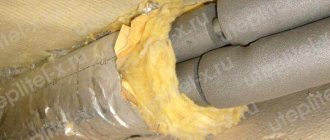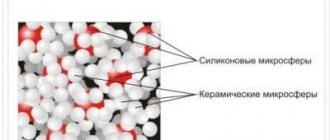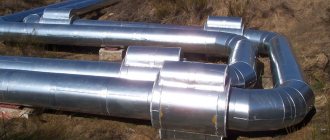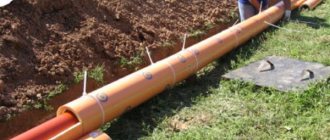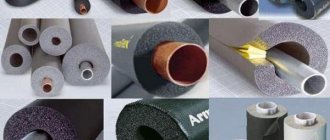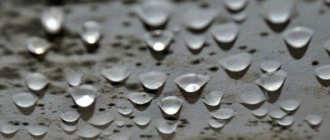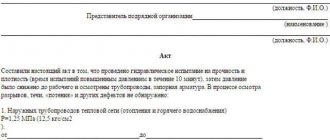During the heating season, which often accounts for most of the year in our country, thermal energy losses inevitably occur. According to static data, heating 1 m2 of building area per year requires 22-28 liters of fuel oil. In Europe, after the energy crisis of 1976, a program was developed and implemented for the efficient use of energy in residential buildings, which reduced energy consumption by 40-47%. In Russia, energy saving was introduced into the rank of state policy in the mid-90s. XX century One of the most important elements of the implementation of this policy is the reduction of losses in transport pipelines, the length of which in the Russian Federation, according to Rosstat, is about 170 thousand kilometers. Thus, the efficiency and availability of pipe insulation largely determines the performance of the energy industry as a whole. Considering the fact that the costs of installing thermal insulation of pipelines are extremely insignificant in the structure of capital costs for heating networks (up to 5-7%), and the economic effect exceeds the costs several times, the correct choice of materials and installation components is decisive.
Practical purpose of pipeline insulation
Requirements for thermal insulation materials, products and structures, rules for designing thermal insulation on the territory of the Russian Federation are regulated by SP 61.13330.2012 “Thermal insulation of equipment and pipelines”. According to this joint venture, the thermal insulation structure must provide:
- parameters of the coolant during operation;
- standard level of heat losses by equipment and pipelines
- safe temperature for humans on their outer surfaces.
Insulation of pipes with K-Flex insulation
Modern pipe insulation involves the use of new technologies and materials that have all the necessary properties for better thermal protection. – an effective solution to the problem of reliable and efficient pipe insulation. Foamed synthetic rubber as a thermal protection material, in addition to its excellent thermal insulation function, provides excellent sound insulation and reduces various noises. Italian K-Flex insulation on our website is represented by a wide range of both pipe and sheet thermal insulation materials made of foamed synthetic rubber. It is worth noting the easy installation of K-Flex insulation to pipes using special fastening pins and glue. Also, insulating aluminum tapes are always available for protection in hard-to-reach places and at insulation joints.
Requirements for pipeline thermal insulation:
Thermal insulation structures of pipelines and equipment must meet the requirements:
- energy efficiency - have an optimal ratio between the cost of the thermal insulation structure and the cost of heat losses through the insulation during the design service life;
- operational reliability and durability - withstand operational temperature, mechanical, chemical and other influences during the design service life without reducing heat-shielding properties and destruction;
- safety for the environment and operating personnel during operation and disposal.
- materials used in thermal insulation structures must not emit harmful, flammable, explosive, or unpleasant-smelling substances during operation, as well as pathogenic bacteria, viruses and fungi in quantities exceeding the maximum permissible concentrations established in sanitary standards.
Criteria for choosing thermal insulation material for pipes:
When choosing materials and products included in thermal insulation structures for surfaces with positive coolant temperatures (20 °C and above), the following factors should be taken into account:
- location of the isolated object (location region, according to SP 131.13330 “Construction climatology”);
- temperature of the insulated surface;
- ambient temperature;
- fire safety requirements;
- aggressiveness of the environment or substances contained in isolated objects;
- corrosive effects;
- surface material of the isolated object;
- permissible loads on the insulated surface;
- presence of vibration and shock impacts;
- the required durability of the thermal insulation structure;
- sanitary and hygienic requirements;
- temperature of application of thermal insulation material;
- thermal conductivity of thermal insulation material;
- temperature deformations of insulated surfaces;
- configuration and dimensions of the insulated surface;
- installation conditions (crowded conditions, altitude, seasonality, etc.);
- conditions for dismantling and disposal;
- The thermal insulation structure of underground ductless heating network pipelines must withstand without destruction:
- groundwater impact;
- loads from the mass of the overlying soil and passing vehicles.
When choosing thermal insulation materials and structures for surfaces with a coolant temperature of 19 °C or lower and negative temperatures, the relative humidity of the surrounding air, as well as the humidity and vapor permeability of the thermal insulation material should be additionally taken into account.
According to current building codes, any heating system is subject to insulation, regardless of the type of pipeline installation and coolant parameters. Additionally, to achieve the maximum effect of saving thermal energy, hatches of technical wells and chambers, shut-off valves, control units and other connecting elements (both flanged and threaded) are subject to insulation.
Thermal insulation for outdoor heating pipes: types of materials
In the practice of private construction, it is not so common, but there are still situations when heating communications need to be not only distributed throughout the premises of the main house, but also extended to other nearby buildings. These could be residential outbuildings, outbuildings, summer kitchens, utility or agricultural buildings, for example, used for keeping pets or birds. The option cannot be ruled out when, on the contrary, the autonomous boiler room itself is located in a separate building, at some distance from the main residential building. It happens that a house is connected to a central heating main, from which pipes are extended to it.
Thermal insulation for outdoor heating pipes
There are two options for laying heating pipes between buildings - underground (ducted or ductless) and open. The process of installing a local heating main above the ground seems less labor-intensive, and this option is used more often in conditions of independent construction. One of the main conditions for the efficiency of the system is properly planned and well-executed thermal insulation for outdoor heating pipes. It is this issue that will be addressed in this publication.
Why do you need thermal insulation of pipes and the basic requirements for it?
It would seem nonsense - why insulate the already almost always hot pipes of the heating system? Perhaps someone may be misled by a peculiar “play on words”. In the case under consideration, of course, it would be more correct to conduct the conversation using the concept of “thermal insulation”.
Thermal insulation work on any pipelines has two main goals:
- If pipes are used in heating or hot water supply systems, then reducing heat losses and maintaining the required temperature of the pumped liquid comes to the fore. The same principle is also true for industrial or laboratory installations, where technology requires maintaining a certain temperature of the substance transmitted through pipes.
- For cold water supply pipelines or sewer communications, the main factor is insulation, that is, preventing the temperature in the pipes from falling below a critical level, preventing freezing, leading to failure of the system and deformation of the pipes.
By the way, such a precaution is required for both heating mains and hot water pipes - no one is completely immune from emergency situations with boiler equipment.
The cylindrical shape of the pipes itself predetermines a very large area of constant heat exchange with the environment, which means significant heat loss. And they naturally increase as pipeline diameters increase. The table below clearly shows how the amount of heat loss changes depending on the temperature difference inside and outside the pipe (Δt° column), on the diameter of the pipes and on the thickness of the thermal insulation layer (data given taking into account the use of insulation material with an average thermal conductivity coefficient λ = 0.04 W/m×°C).
| The thickness of the thermal insulation layer. mm | Δt.°С | Pipe outer diameter (mm) | |||||||||
| 15 | 20 | 25 | 32 | 40 | 50 | 65 | 80 | 100 | 150 | ||
| The amount of heat loss (per 1 linear meter of pipeline. W). | |||||||||||
| 10 | 20 | 7.2 | 8.4 | 10 | 12 | 13.4 | 16.2 | 19 | 23 | 29 | 41 |
| 30 | 10.7 | 12.6 | 15 | 18 | 20.2 | 24.4 | 29 | 34 | 43 | 61 | |
| 40 | 14.3 | 16.8 | 20 | 24 | 26.8 | 32.5 | 38 | 45 | 57 | 81 | |
| 60 | 21.5 | 25.2 | 30 | 36 | 40.2 | 48.7 | 58 | 68 | 86 | 122 | |
| 20 | 20 | 4.6 | 5.3 | 6.1 | 7.2 | 7.9 | 9.4 | 11 | 13 | 16 | 22 |
| 30 | 6.8 | 7.9 | 9.1 | 10.8 | 11.9 | 14.2 | 16 | 19 | 24 | 33 | |
| 40 | 9.1 | 10.6 | 12.2 | 14.4 | 15.8 | 18.8 | 22 | 25 | 32 | 44 | |
| 60 | 13.6 | 15.7 | 18.2 | 21.6 | 23.9 | 28.2 | 33 | 38 | 48 | 67 | |
| 30 | 20 | 3.6 | 4.1 | 4.7 | 5.5 | 6 | 7 | 8 | 9 | 11 | 16 |
| 30 | 5.4 | 6.1 | 7.1 | 8.2 | 9 | 10.6 | 12 | 14 | 17 | 24 | |
| 40 | 7.3 | 8.31 | 9.5 | 10.9 | 12 | 14 | 16 | 19 | 23 | 31 | |
| 60 | 10.9 | 12.4 | 14.2 | 16.4 | 18 | 21 | 24 | 28 | 34 | 47 | |
| 40 | 20 | 3.1 | 3.5 | 4 | 4.6 | 4.9 | 5.8 | 7 | 8 | 9 | 12 |
| 30 | 4.7 | 5.3 | 6 | 6.8 | 7.4 | 8.6 | 10 | 11 | 14 | 19 | |
| 40 | 6.2 | 7.1 | 7.9 | 9.1 | 10 | 11.5 | 13 | 15 | 18 | 25 | |
| 60 | 9.4 | 10.6 | 12 | 13.7 | 14.9 | 17.3 | 20 | 22 | 27 | 37 | |
As the thickness of the insulation layer increases, the overall heat loss rate decreases. However, please note that even a fairly thick layer of 40 mm does not completely eliminate heat loss. There is only one conclusion - it is necessary to strive to use insulation materials with the lowest possible thermal conductivity coefficient - this is one of the main requirements for thermal insulation of pipelines.
Sometimes a pipeline heating system is also required!
When laying water supply or sewer lines, it happens that due to the local climate or specific installation conditions, thermal insulation alone is clearly not enough. We have to resort to forced heating of the water supply and installation of heating cables - this topic is discussed in more detail in a special publication on our portal.
- The material used for thermal insulation of pipes, if possible, should have hydrophobic properties. There will be little current from insulation soaked in water - it will not prevent heat loss, and itself will soon collapse under the influence of negative temperatures.
- The thermal insulation structure must have reliable external protection. Firstly, it needs protection from atmospheric moisture, especially if insulation is used that can actively absorb water. Secondly, materials should be protected from exposure to the ultraviolet spectrum of sunlight, which has a detrimental effect on them. Thirdly, we should not forget about the wind load, which can damage the integrity of the thermal insulation. And fourthly, there remains the factor of external mechanical impact, unintentional, including from animals, or due to banal manifestations of vandalism.
Such insulation of the heating main is unlikely to be effective, and it spoils the view.
In addition, any owner of a private house is probably not indifferent to the aesthetic appearance of the laid heating main.
- Any thermal insulation material used on heating mains must have an operating temperature range that corresponds to the actual conditions of use.
- An important requirement for insulating material and its external cladding is durability of use. No one wants to return to the problems of thermal insulation of pipes even once every few years.
- From a practical point of view, one of the main requirements is the ease of installation of thermal insulation, in any position and in any difficult area. Fortunately, in this regard, manufacturers never tire of delighting with easy-to-use developments.
- An important requirement for thermal insulation is that its materials themselves must be chemically inert and not enter into any reaction with the surface of the pipes. Such compatibility is the key to long-term trouble-free operation.
The issue of cost is also very important. But in this regard, the price range for specialized pipe insulation is very large.
What materials are used for insulation of above-ground heating mains
The choice of thermal insulation materials for heating pipes when they are laid externally is quite large. They come in roll type or in the form of mats; they can be given a cylindrical or other shaped shape that is convenient for installation; there are insulation materials that are applied in liquid form and acquire their properties only after hardening.
Insulation using foamed polyethylene
Foamed polyethylene is rightly classified as a very effective thermal insulator. And what is also very important, the cost of this material is one of the lowest.
The thermal conductivity coefficient of foamed polyethylene is usually around 0.035 W/m×°C - this is a very good indicator. The smallest bubbles, isolated from each other, filled with gas, create an elastic structure, and with such material, if you purchase a roll version, it is very convenient to work on sections of pipes with complex configurations.
Thermal insulating tubes made of foamed polyethylene
Such a structure becomes a reliable barrier to moisture - if installed correctly, neither water nor water vapor will be able to penetrate through it to the pipe walls.
The density of polyethylene foam is low (about 30 - 35 kg/m³), and thermal insulation will not make the pipes heavier.
The material, with some assumption, can be classified as low-hazard in terms of flammability - it usually belongs to class G-2, that is, it is very difficult to ignite, and without an external flame it quickly extinguishes. Moreover, combustion products, unlike many other thermal insulators, do not pose any serious toxic danger to humans.
Rolled foam polyethylene for insulation of external heating mains will be both inconvenient and unprofitable - you will have to wind it in several layers to achieve the required thickness of thermal insulation. Much more convenient to use is material in the form of sleeves (cylinders), which have an internal channel corresponding to the diameter of the insulated pipe. To put it on pipes, an incision is usually made along the length of the cylinder on the wall, which after installation can be sealed with reliable tape.
Putting insulation on a pipe is not difficult
A more effective type of polyethylene foam is penofol, which has a foil layer on one side. This shiny coating becomes a kind of thermal reflector, which significantly increases the insulating qualities of the material. In addition, it is an additional barrier against moisture penetration.
Penofol can also be of a roll type or in the form of profile cylindrical elements - especially for thermal insulation of pipes for various purposes.
Insulation parts made of foil polyethylene foam for various types of pipes
And foamed polyethylene is rarely used for thermal insulation of heating mains. It is more likely to be suitable for other communications. The reason for this is the rather low operating temperature range. So. if you look at the physical characteristics, the upper limit balances somewhere on the verge of 75 ÷ 85 degrees - above that, structural disturbances and the appearance of deformations are possible. For autonomous heating, most often, this temperature is sufficient, although on the verge, and for central heating, thermal stability is clearly not enough.
Insulation elements made of polystyrene foam
The well-known expanded polystyrene (in everyday life it is more often called polystyrene foam) is very widely used for a variety of types of thermal insulation work. The insulation of pipes is no exception - special parts are made from foam plastic for this purpose.
Two mating polystyrene foam shell half-cylinders for pipes
Usually these are half-cylinders (for pipes of large diameters there may be segments of a third of the circumference, 120° each), which for assembly into a single structure are equipped with a tongue-and-groove type locking connection. This configuration makes it possible to provide reliable thermal insulation completely over the entire surface of the pipe, without remaining “cold bridges.”
In everyday speech, such details are called “shells” for their obvious resemblance to it. There are many types of it available, for different outer diameters of insulated pipes and different thicknesses of the thermal insulation layer. Typically the length of the parts is 1000 or 2000 mm.
For production, polystyrene foam of the PSB-S type of various grades is used - from PSB-S-15 to PSB-S-35. The main parameters of this material are shown in the table below:
| Estimated material parameters | Brand of expanded polystyrene | ||||
| PSB-S-15U | PSB-S-15 | PSB-S-25 | PSB-S-35 | PSB-S-50 | |
| Density (kg/m³) | to 10 | up to 15 | 15,1 ÷ 25 | 25,1 ÷ 35 | 35,1 ÷ 50 |
| Compressive strength at 10% linear deformation (MPa, not less) | 0.05 | 0.06 | 0.08 | 0.16 | 0.2 |
| Bending strength (MPa, not less) | 0.08 | 0.12 | 0.17 | 0.36 | 0.35 |
| Thermal conductivity in dry condition at a temperature of 25°C (W / (m×°K)) | 0,043 | 0,042 | 0,039 | 0,037 | 0,036 |
| Water absorption in 24 hours (% by volume, no more) | 3 | 2 | 2 | 2 | 2 |
| Humidity (%, no more) | 2.4 | 2.4 | 2.4 | 2.4 | 2.4 |
The advantages of polystyrene foam as an insulating material have long been known:
- It has a low thermal conductivity coefficient.
- The light weight of the material greatly simplifies insulation work, which does not require any special mechanisms or devices.
- The material is biologically inert - it will not be a breeding ground for the formation of mold or mildew.
- Moisture absorption is negligible.
- The material can be easily cut and adjusted to the desired size.
- Polystyrene foam is chemically inert and absolutely safe for pipe walls, no matter what material they are made of.
- One of the key advantages is that polystyrene foam is one of the most inexpensive insulation materials.
However, it also has many disadvantages:
- First of all, this is a low level of fire safety. The material cannot be called non-flammable and does not spread flame. That is why, when using it to insulate above-ground pipelines, fire breaks must be left.
- The material does not have elasticity, and it is convenient to use it only on straight sections of pipe. True, you can also find special figured parts.
Shell element for insulating the area at the bend of the pipeline
- Polystyrene foam is not a durable material - it is easily destroyed under external influence. Ultraviolet radiation also has a negative effect on it. In a word, above-ground sections of the pipe, insulated with polystyrene foam shells, will definitely require additional protection in the form of a metal casing.
Ready-made galvanized sheets for installing a protective casing
Usually, stores that sell foam shells also offer galvanized sheets, cut to the required size, corresponding to the diameter of the insulation. An aluminum shell can also be used, although it is of course much more expensive. The sheets can be secured with self-tapping screws or clamps - the resulting casing will simultaneously create anti-vandal, anti-wind, waterproofing protection and a barrier from sunlight.
- And yet this is not even the main thing. The upper limit of normal operating temperatures is only around 75°C, after which linear and spatial deformation of parts may begin. Whatever one may say, this value may not be enough for heating. It probably makes sense to look for a more reliable option.
Insulation of pipes with mineral wool or products based on it
The most “ancient” method of thermal insulation of external pipelines is using mineral wool. By the way, it is also the most budget-friendly, if it is not possible to purchase a foam shell.
Heating pipe insulated with mineral wool
For thermal insulation of pipelines, various types of mineral wool are used - glass wool, stone (basalt) and slag. Slag is the least preferable: firstly, it absorbs moisture most actively, and secondly, its residual acidity can have a very destructive effect on steel pipes. Even the cheapness of this cotton wool does not in any way justify the risks of its use.
But mineral wool based on basalt or glass fibers is fully suitable. It has good thermal resistance to heat transfer, high chemical resistance, the material is elastic, and it is easy to install even on complex pipeline sections. Another advantage is that you can, in principle, be completely calm in terms of fire safety. It is almost impossible to heat mineral wool to the point of ignition in the conditions of an external heating main. Even exposure to an open flame will not cause a fire to spread. That is why mineral wool is used to fill fire gaps when using other pipe insulation materials.
It is best to use mats that have stitching or mesh reinforcement
The main disadvantage of mineral wool is its high water absorption (basalt wool is less susceptible to this “disease”). This means that any pipeline will require mandatory protection from moisture. In addition, the structure of the wool is unstable to mechanical stress, is easily destroyed, and should be protected with a durable casing.
Usually they use durable polyethylene film, which is securely wrapped in a layer of insulation, with the obligatory overlap of the strips by 400 ÷ 500 mm, and then the whole thing is covered with metal sheets on top - exactly by analogy with a polystyrene foam shell. Roofing felt can also be used as waterproofing - in this case, 100 ÷ 150 mm of overlap of one strip over another will be sufficient.
Existing GOST standards determine the thickness of protective metal coatings for open sections of pipelines for any type of thermal insulation materials used:
| Protective cover layer material | Minimum metal thickness, with outer diameter of insulation | ||
| 350 or less | Over 350 and up to 600 | Over 600 and up to 1600 | |
| Stainless steel strips and sheets | 0.5 | 0.5 | 0.8 |
| Sheets made of thin sheet steel, galvanized or polymer coated | 0.5 | 0.8 | 0.8 |
| Aluminum or aluminum alloy sheets | 0.3 | 0.5 | 0.8 |
| Aluminum or aluminum alloy tapes | 0.25 | — | — |
Thus, despite the seemingly inexpensive price of the insulation itself, its full installation will require considerable additional costs.
Mineral wool for insulation of pipelines can also act in another capacity - it serves as a material for the manufacture of finished thermal insulation parts, by analogy with polyethylene foam cylinders. Moreover, such products are produced both for straight sections of pipelines and for bends, tees, etc.
Elements are available for both straight and curved pipe sections
Typically, such insulating parts are made from the densest material - basalt mineral wool, and have an external foil coating, which immediately eliminates the problem of waterproofing and increases the efficiency of insulation. But you still won’t be able to get away from the outer casing - a thin layer of foil will not protect you from accidental or intentional mechanical impact.
Insulation of heating mains with polyurethane foam
One of the most effective and safest modern insulation materials is polyurethane foam. It has a lot of various advantages, so the material is used on almost any structure that requires reliable insulation.
What are the features of polyurethane foam insulation?
In order not to repeat ourselves, it is advisable to recommend that the reader read in more detail a special article on the portal, which is entirely devoted to the advantages and disadvantages of polyurethane foam as a thermal insulation material.
Polyurethane foam for pipeline insulation can be used in various forms.
- PPU shells are widely used, usually having an outer foil coating. It can be dismountable, consisting of half-cylinders with tongue-and-groove locks, or, for small-diameter pipes, with a cut along the length and a special valve with a self-adhesive rear surface, which greatly simplifies the installation of insulation.
Polyurethane foam shell of various types
- Another way to thermally insulate a heating main with polyurethane foam is to spray it in liquid form using special equipment. The resulting layer of foam, after complete hardening, becomes an excellent insulation material. This technology is especially convenient at complex junctions, pipe turns, in units with shut-off and control valves, etc.
Insulation of heating mains by spraying polyurethane foam
The advantage of this technology is that, thanks to the excellent adhesion of sprayed polyurethane foam to the surface of the pipes, excellent waterproofing and anti-corrosion protection is created. True, the polyurethane foam itself also requires mandatory protection - from ultraviolet rays, so again it will not be possible to do without a casing.
- Well, if you need to lay a fairly long heating main, then probably the best choice would be to use pre-insulated (pre-insulated) pipes.
Pre-insulated pipes for above-ground installation
Essentially, such pipes are a multi-layer structure assembled in a factory:
— The inner layer is, in fact, the steel pipe itself of the required diameter, through which the coolant is pumped.
— The outer coating is protective. It can be polymer (for laying a heating main in the thickness of the soil) or galvanized metal - what is required for open sections of the pipeline.
— Between the pipe and the casing, a monolithic, seamless layer of polyurethane foam is poured, which performs the function of effective thermal insulation.
An installation section is left at both ends of the pipe for welding work when assembling the heating main. Its length is designed in such a way that the heat flow from the welding arc will not damage the polyurethane foam layer.
After installation, the remaining uninsulated areas are primed, covered with a polyurethane foam shell, and then with metal belts, comparing the coating with the overall outer casing of the pipe. It is often in such areas that fire breaks are organized - they are tightly filled with mineral wool, then waterproofed with roofing felt and still covered on top with a steel or aluminum casing.
The standards establish a certain range of such sandwich pipes, that is, it is possible to purchase products of the required nominal diameter with optimal (regular or reinforced) thermal insulation.
| Outer diameter of steel pipe and minimum wall thickness (mm) | Dimensions of galvanized sheet steel shell | Estimated thickness of the thermal insulation layer of polyurethane foam (mm) | |
| nominal outer diameter (mm) | minimum thickness of steel sheet (mm) | ||
| 32 × 3,0 | 100; 125; 140 | 0.55 | 46,0; 53,5 |
| 38 × 3,0 | 125; 140 | 0.55 | 43,0; 50,5 |
| 45 × 3,0 | 125; 140 | 0.55 | 39,5; 47,0 |
| 57 × 3,0 | 140 | 0.55 | 40.9 |
| 76 × 3,0 | 160 | 0.55 | 41.4 |
| 89 × 4,0 | 180 | 0.6 | 44.9 |
| 108 × 4,0 | 200 | 0.6 | 45.4 |
| 133 × 4,0 | 225 | 0.6 | 45.4 |
| 159 × 4,5 | 250 | 0.7 | 44.8 |
| 219 × 6,0 | 315 | 0.7 | 47.3 |
| 273 × 7,0 | 400 | 0.8 | 62.7 |
| 325 × 7,0 | 450 | 0.8 | 61.7 |
Manufacturers offer such sandwich pipes not only for straight sections, but also for tees, bends, compensators, etc.
Pre-insulated bends
The cost of such pre-insulated pipes is quite high, but their acquisition and installation solves a whole range of problems at once. So such costs seem quite justified.
Video: the production process of pre-insulated pipes
Insulation – foam rubber
Thermal insulation materials and products made from synthetic foam rubber have recently become very popular. This material has a number of advantages that bring it to a leading position in matters of insulation of pipelines, including not only heating mains, but also more critical ones - on complex technological lines, in machine, aircraft and shipbuilding:
- Foam rubber is very elastic, but at the same time has a large margin of tensile strength.
- The density of the material is only from 40 to 80 kg/m³.
- The low thermal conductivity coefficient provides very effective thermal insulation.
- The material does not shrink over time, completely retaining its original shape and volume.
- Foamed rubber is difficult to ignite and has the property of rapid self-extinguishing.
- The material is chemically and biologically inert; there are no pockets of mold or mildew, or nests of insects or rodents in it.
- The most important quality is almost absolute water and vapor tightness. Thus, the insulating layer immediately becomes an excellent waterproofing for the surface of the pipe.
Thermal insulation tubes and foam rubber sheets
Such thermal insulation can be produced in the form of hollow tubes with an internal diameter from 6 to 160 mm and an insulation layer thickness of 6 to 32 mm, or in the form of sheets, which are often given a “self-adhesive” function on one side "
| The name of indicators | Values |
| Length of finished tubes, mm: | 1000 or 2000 |
| Color | black or silver, depending on the type of protective coating |
| Temperature range of application: | from - 50 to + 110 °C |
| Thermal conductivity, W/(m ×°C): | λ≤0.036 at 0°C |
| λ≤0.039 at a temperature of +40°C | |
| Vapor permeation resistance coefficient: | μ≥7000 |
| Fire hazard level | Group G1 |
| Allowable length change: | ±1,5% |
But for heating mains located in the open air, ready-made insulation elements made using the Armaflex ACE technology and having a special protective coating ArmaChek are especially convenient.
Insulation elements for pipelines "Armaflex ACE" with external coating "ArmaChek"
ArmaChek coating can be of several types, for example:
- "Arma-Chek Silver" is a multi-layer PVC-based shell with a silver reflective coating. This coating provides excellent protection of the insulation from both mechanical stress and ultraviolet rays.
- The black Arma-Chek D coating has a fiberglass base that is highly durable but retains excellent flexibility. This is excellent protection against all possible chemical, weather, and mechanical influences, which will keep the heating pipe intact.
Typically, such products using the ArmaChek technology have self-adhesive valves that hermetically “seal” the insulating cylinder on the pipe body. Curved elements are also produced that allow installation in difficult sections of the heating main. Skillful use of such thermal insulation allows you to quickly and reliably install it, without resorting to creating an additional external protective casing - there is simply no need for it.
The only thing, probably, that is hindering the widespread use of such thermal insulation products for pipelines is the still prohibitively high price for real, “branded” products.
Prices for thermal insulation for pipes
Thermal insulation for pipes
A new direction in insulation - thermal insulation paint
You can’t miss another modern insulation technology. And it’s all the more pleasant to talk about it, since it is the development of Russian scientists. We are talking about ceramic liquid insulation, which is also known as heat-insulating paint.
This is, without any doubt, an “alien” from the sphere of space technology. It is in this scientific and technical field that the issues of thermal insulation from critically low (in outer space) or high (during the launch of ships and landing of descent vehicles) are especially acute.
The thermal insulation qualities of ultra-thin coatings seem simply fantastic. At the same time, such a coating becomes an excellent hydro- and vapor barrier, protecting the pipe from all possible external influences. Well, the heating main itself takes on a well-groomed, pleasing appearance.
Pipeline coated with thermal insulating paint
The paint itself is a suspension of microscopic, vacuum-filled silicone and ceramic capsules suspended in a liquid state in a special composition, including acrylic, rubber and other components. After applying and drying the composition, a thin elastic film is formed on the surface of the pipe, which has outstanding thermal insulation properties.
| Names of indicators | Unit | Magnitude |
| Paint color | white (can be customized) | |
| Appearance after application and complete hardening | matte, smooth, homogeneous surface | |
| Film elasticity when bending | mm | 1 |
| Coating adhesion based on pull-off force from the painted surface | ||
| - to the concrete surface | MPa | 1.28 |
| - to a brick surface | MPa | 2 |
| - to steel | MPa | 1.2 |
| Resistance of the coating to temperature changes from -40 °C to + 80 °C | without changes | |
| Resistance of the coating to temperatures of +200 °C for 1.5 hours | no yellowing, cracks, peeling or bubbles | |
| Durability for concrete and metal surfaces in cold-temperate climates (Moscow) | years | at least 10 |
| Thermal conductivity | W/m °C | 0,0012 |
| Vapor permeability | mg/m × h × Pa | 0.03 |
| Water absorption in 24 hours | % by volume | 2 |
| Operating temperature range | °C | from - 60 to + 260 |
Such a coating will not require additional protective layers - it is strong enough to independently cope with all impacts.
Example of commercially available thermal insulation paint
This liquid insulation is sold in plastic cans (buckets), just like regular paint. There are several manufacturers, and among the domestic ones we can especially mention “Korund”.
Applying this composition is no different from conventional pipe painting.
This thermal paint can be applied by aerosol spraying or in the usual way - with a roller and brush. The number of layers depends on the operating conditions of the heating main, climatic region, pipe diameter, and average temperature of the pumped coolant.
Many experts believe that such insulation materials will eventually replace conventional thermal insulation materials on a mineral or organic basis.
Video: presentation of ultra-thin thermal insulation of the Korund brand
Prices for thermal insulation paint
Thermal insulation paint
What thickness of heating main insulation is required?
To summarize the review of materials used for thermal insulation of heating pipes, we can put the performance indicators of the most popular ones in the table - for clarity of comparison:
| Thermal insulation material or product | Average density in the finished structure, kg/m3 | Thermal conductivity of thermal insulation material (W/(m×°C)) for surfaces with temperature (°C) | Operating temperature range, °C | Flammability group | |
| 20 and above | 19 and below | ||||
| Mineral wool slabs pierced | 120 | 0,045 | 0,044 ÷ 0,035 | From - 180 to + 450 for mats, on fabric, mesh, fiberglass canvas; up to + 700 - on a metal mesh | Non-flammable |
| 150 | 0,05 | 0,048 ÷ 0,037 | |||
| Thermal insulation slabs made of mineral wool with a synthetic binder | 65 | 0.04 | 0,039 ÷ 0,03 | From - 60 to + 400 | Non-flammable |
| 95 | 0,043 | 0,042 ÷ 0,031 | |||
| 120 | 0,044 | 0,043 ÷ 0,032 | From — 180 + 400 | ||
| 180 | 0,052 | 0,051 ÷ 0,038 | |||
| Thermal insulation products made of foamed ethylene-polypropylene rubber "Aeroflex" | 60 | 0,034 | 0,033 | From - 55 to + 125 | Low flammable |
| Half-cylinders and mineral wool cylinders | 50 | 0,04 | 0,039 ÷ 0,029 | From - 180 to + 400 | Non-flammable |
| 80 | 0,044 | 0,043 ÷ 0,032 | |||
| 100 | 0,049 | 0,048 ÷ 0,036 | |||
| 150 | 0,05 | 0,049 ÷ 0,035 | |||
| 200 | 0,053 | 0,052 ÷ 0,038 | |||
| Thermal insulation cord made of mineral wool | 200 | 0,056 | 0,055 ÷ 0,04 | From - 180 to + 600 depending on the material of the mesh tube | In mesh tubes made of metal wire and glass thread - non-flammable, the rest are low-flammable |
| Glass staple fiber mats with synthetic binder | 50 | 0,04 | 0,039 ÷ 0,029 | From - 60 to + 180 | Non-flammable |
| 70 | 0,042 | 0,041 ÷ 0,03 | |||
| Mats and wadding made of superfine glass fiber without binder | 70 | 0,033 | 0,032 ÷ 0,024 | From - 180 to + 400 | Non-flammable |
| Mats and wool made of superfine basalt fiber without binder | 80 | 0,032 | 0,031 ÷ 0,024 | From - 180 to + 600 | Non-flammable |
| Perlite sand, expanded, fine | 110 | 0,052 | 0,051 ÷ 0,038 | From - 180 to + 875 | Non-flammable |
| 150 | 0,055 | 0,054 ÷ 0,04 | |||
| 225 | 0,058 | 0,057 ÷ 0,042 | |||
| Thermal insulation products made of polystyrene foam | 30 | 0,033 | 0,032 ÷ 0,024 | From - 180 to + 70 | Flammable |
| 50 | 0,036 | 0,035 ÷ 0,026 | |||
| 100 | 0,041 | 0,04 ÷ 0,03 | |||
| Thermal insulation products made of polyurethane foam | 40 | 0,030 | 0,029 ÷ 0,024 | From - 180 to + 130 | Flammable |
| 50 | 0,032 | 0,031 ÷ 0,025 | |||
| 70 | 0,037 | 0,036 ÷ 0,027 | |||
| Thermal insulation products made of polyethylene foam | 50 | 0,035 | 0,033 | From - 70 to + 70 | Flammable |
But surely an inquisitive reader will ask: where is the answer to one of the main questions that arises - what should be the thickness of the insulation?
This question is quite complex, and there is no clear answer to it. If desired, you can use cumbersome calculation formulas, but they are probably understandable only to qualified heating engineers. However, not everything is so scary.
Manufacturers of finished thermal insulation products (shells, cylinders, etc.) usually provide the required thickness calculated for a specific region. And if mineral wool insulation is used, then you can use the data from the tables that are given in a special Code of Rules, which was developed specifically for thermal insulation of pipelines and process equipment. This document is easy to find on the Internet by asking the search query “SP 41-103-2000”.
Here, for example, is a table from this reference book regarding the above-ground placement of a pipeline in the Central region of Russia, when using mats made of glass staple fiber grade M-35, 50:
| Pipeline outer diameter, mm | Heating pipe type | |||||
| innings | return | innings | return | innings | return | |
| Average temperature regime of the coolant, °C | ||||||
| 65 | 50 | 90 | 50 | 110 | 50 | |
| Required insulation thickness, mm | ||||||
| 45 | 50 | 50 | 45 | 45 | 40 | 40 |
| 57 | 58 | 58 | 48 | 48 | 45 | 45 |
| 76 | 67 | 67 | 51 | 51 | 50 | 50 |
| 89 | 66 | 66 | 53 | 53 | 50 | 50 |
| 108 | 62 | 62 | 58 | 58 | 55 | 55 |
| 133 | 68 | 68 | 65 | 65 | 61 | 61 |
| 159 | 74 | 74 | 64 | 64 | 68 | 68 |
| 219 | 78 | 78 | 76 | 76 | 82 | 82 |
| 273 | 82 | 82 | 84 | 84 | 92 | 92 |
| 325 | 80 | 80 | 87 | 87 | 93 | 93 |
In a similar way, you can find the necessary parameters for other materials. By the way, the same Code of Rules does not recommend significantly exceeding the specified thickness. Moreover, the maximum values of the insulating layer for pipelines have been determined:
| Pipeline outer diameter, mm | Maximum thickness of thermal insulation layer, mm | |
| temperature 19 ° C and below | temperature 20 ° C or more | |
| 18 | 80 | 80 |
| 25 | 120 | 120 |
| 32 | 140 | 140 |
| 45 | 140 | 140 |
| 57 | 150 | 150 |
| 76 | 160 | 160 |
| 89 | 180 | 170 |
| 108 | 180 | 180 |
| 133 | 200 | 200 |
| 159 | 220 | 220 |
| 219 | 230 | 230 |
| 273 | 240 | 230 |
| 325 | 240 | 240 |
However, do not forget about one important nuance. The fact is that any insulation with a fibrous structure inevitably shrinks over time. This means that after a certain period of time its thickness may become insufficient for reliable thermal insulation of the heating main. There is only one way out - even when installing insulation, immediately take into account this adjustment for shrinkage.
To calculate, you can use the following formula:
H = (( D + h ) : ( D + 2 h )) × h × Kc
N – thickness of the mineral wool layer, taking into account the correction for compaction.
D – outer diameter of the pipe to be insulated;
h – required insulation thickness according to the table of the Code of Rules.
Kc is the shrinkage (compaction) coefficient of fiber insulation. It is a calculated constant, the value of which can be taken from the table below:
| Thermal insulation materials and products | Compaction coefficient Kc. |
| Stitched mineral wool mats | 1.2 |
| Heat-insulating mats "TEKHMAT" | 1,35 ÷ 1,2 |
| Mats and canvases made of super-thin basalt fiber when laid on pipelines and equipment with a nominal diameter, mm: | |
| • Do | 3 |
| ̶ the same, with an average density of 50-60 kg/m3 | 1,5 |
| • DN ≥ 800 with an average density of 23 kg/m3 | 2 |
| ̶ the same, with an average density of 50-60 kg/m3 | 1,5 |
| Mats made of glass staple fiber on a synthetic binder brand: | |
| • M-45, 35, 25 | 1.6 |
| • M-15 | 2.6 |
| Mats made from glass staple fiber "URSA" brand: | |
| • M-11: | |
| ̶ for pipes with DN up to 40 mm | 4,0 |
| ̶ for pipes with DN 50 mm and above | 3,6 |
| • M-15, M-17 | 2.6 |
| • M-25: | |
| ̶ for pipes with DN up to 100 mm | 1,8 |
| ̶ for pipes with DN from 100 to 250 mm | 1,6 |
| ̶ for pipes with DN over 250 mm | 1,5 |
| Mineral wool slabs with synthetic binder brand: | |
| • 35, 50 | 1.5 |
| • 75 | 1.2 |
| • 100 | 1.10 |
| • 125 | 1.05 |
| Glass staple fiber slabs brand: | |
| • P-30 | 1.1 |
| • P-15, P-17 and P-20 | 1.2 |
To help the interested reader, below is a special calculator, which already contains the indicated ratio. You just need to enter the requested parameters and immediately get the required thickness of mineral wool insulation, taking into account the correction.
Calculator for calculating the thickness of pipe insulation with mineral wool, taking into account material shrinkage
Go to calculations
What are the types of thermal insulation?
Conventionally, thermal insulation materials can be divided into 2 large groups:
1. Thermal insulation from inorganic materials, mainly based on silicon - fibrous (mineral wool and products made from it, mullite-silica materials); and also with closed porosity (foam glass, foam concrete). The advantages of such thermal insulation are fire safety and resistance to aggressive environments. The disadvantages of fibrous materials include hygroscopicity and low compressive strength (at low densities). According to SP 61.13330.2012 “Thermal insulation of equipment and pipelines”, these materials are prohibited from being used for channelless installation of pipelines. In the case of foam glass, the disadvantage is fragility and the high cost of both the material itself and installation work.
2. Thermal insulation from organic materials (polymers) - polystyrene foam, non-pressed and extruded, polyurethane foam, polyisocyanurate, foam rubber and polyethylene. The advantages of this group include high compressive strength, non-hygroscopicity, which makes it possible to avoid installing a vapor barrier layer, good thermal conductivity, and low specific gravity. The main disadvantages are fire hazard, instability to chemical influences, and UV radiation. Such thermal insulation is practically no alternative for ductless pipeline installation.
What features should a heat insulator have?
When choosing insulation, you must first decide on the place where it will be used, outside or inside the house. The choice of thermal insulation material is influenced by:
- diameter of the located pipes;
- heating temperature of the coolant;
- conditions under which the heating system is operated.
The types of insulation used differ depending on the diameter of the existing pipes. Manufacturing companies offer half-cylinders, soft roll insulation and cylinders with a certain rigid design.
For pipelines with small diameters, half-cylinders and cylinders with characteristic rigidity are suitable. This type of design has grooves that greatly simplify installation work. This material has an excellent level of resistance to relatively high temperatures, with minimal water absorption. The rigid heat insulator constantly retains its original shape, providing additional safety from possible mechanical damage.
When choosing, you need to pay attention to the following characteristics of the heat insulator:
- flammability class, which should be especially taken into account for further placement inside residential and industrial buildings;
- the level of water absorption, on which the service life of the material directly depends, because with a high level of moisture absorption, the insulation succumbs to rotting, beginning to decompose, subsequently not representing any effectiveness;
- the degree of resistance to ultraviolet radiation, because material with a low index that is located outside the house will begin to succumb to destruction by sunlight;
- the level of thermal conductivity should be as low as possible, because with a low indicator, the heat insulator saves heat better, allowing the use of insulation with a smaller layer thickness.
Mineral wool
The most common insulation is mineral wool and products made from it. Material made from molten rocks or quartz glass does not burn and is very temperature resistant. Typically requires an additional outer layer of coating. The AMAKS thermal insulation products plant produces the entire main line of materials based on basalt wool:
- Stitched heat-insulating mats : with a density from 50 to 125 kg/m3 (for thin fiber) - these are MP AMAKS and MPB AMAKS and from 20 to 50 kg/m3 (for superfine fiber) - this is MPB BSTV AMAX. They can be manufactured either without lining or with various types of lining (metal mesh, fiberglass, fiberglass, foil, etc.) on 1-6 sides.
- Thermal insulating cylinders TsKV AMAKS and additional elements (tees, bends, tie-ins, plugs, transitions) with a density of 80-200 kg/m3 in various laminated options
- Lamellar mats (vertically layered) of various densities ML AMAKS, density 35, 50, 60, 70 kg/m3, laminated with reinforced foil or foil fabric.
The choice between different options for mineral wool thermal insulation is determined by:
- Requirements for the cover layer. In particular, to install a galvanized casing over a layer of pierced mats, it is necessary to install support rings made of denser material (cylinders) or support rings made of thin sheet metal;
- Ease of installation. Installation of mats lined with metal mesh is more convenient than those without lining, and the installation of heat-insulating cylinders does not require specialists to have insulating skills at all. With a high weight of casings or when placed indoors, it is more convenient to insulate the pipeline with lamella mats, since they can withstand a large load on the surface and are immediately covered with a finishing layer of aluminum foil or foil fabric;
- In some cases, subject to installation indoors - for aesthetic reasons. All other things being equal, neat thermal insulation made from cylinders looks much more aesthetically pleasing compared to, say, mats, and is much more convenient to maintain (wet cleaning, for example).
Polymer organic insulation
Thermal insulation based on polymeric materials is presented in our company’s product range, mainly in the form of hard shells. Extruded polystyrene foam, polyurethane foam, and polyisocyanurate differ from each other in density, structural fire hazard category, and temperature range of application. Rubber and polyethylene are used mainly in low-temperature areas.
Specialists from the AMAKS Thermal Insulation Products Plant are ready to help you understand all the nuances of your pipeline insulation task.
Multilayer structures for pipeline protection
Often, to insulate pipelines, thermal insulation is installed using the “pipe-in-pipe” method.
When using this scheme, a heat-protective casing is installed. The main task of the specialists installing such a circuit is to correctly connect all the parts into a single structure. Upon completion of the work, the result is a design that looks like this:
- the basis of the heat-protective circuit is a pipe made of metal or polymer material. It is the supporting element of the entire device;
- The thermal insulation layers of the structure are made of foamed polyurethane foam. The material is applied using pouring technology; the molten mass is filled into a specially created formwork;
- protective casing. Pipes made of galvanized steel or polyethylene are used for its manufacture. The first ones are used for laying networks in open space. The latter are used in cases where pipeline systems are laid in the ground using ductless technology. copper conductors are placed in insulation based on polyurethane foam , the main purpose of which is to remotely monitor the condition of the pipeline, including the integrity of the thermal insulation layer;
- If the pipes arrive at the installation site in assembled form, then the welding method is used to connect them. Specialists use special heat-shrinkable cuffs to assemble the heat-protective circuit. Or, overhead couplings made from mineral wool, which are covered with a layer of foil, can be used.
